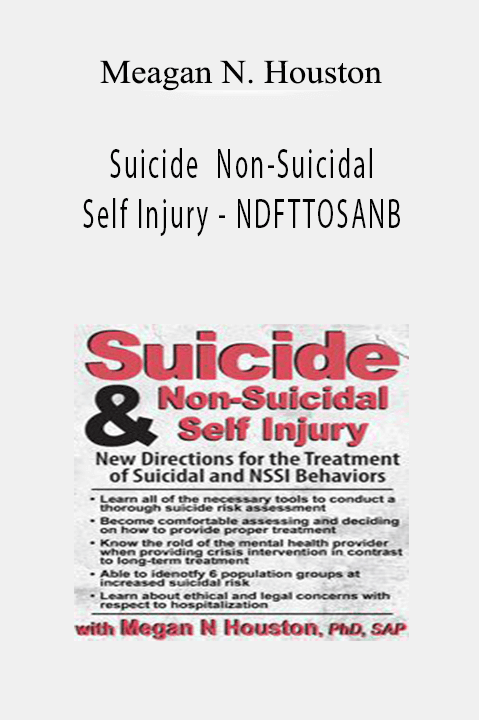Meagan N. Houston – Suicide Non-Suicidal Self Injury – NDFTTOSANB
This recording goes beyond book knowledge of suicide. It’s full of candid, innovative and front line approaches to assessing and providing treatment to clients who present with suicidal and self-destructive behaviors. Practitioners will not only learn how to assess and treat suicidal patients, but will also be provided clinical tools to develop a suicide risk assessment that protects the clinician both ethically and legally.
Drawing from her years of experience across various populations and treatment settings, Dr. Meagan Houston will provide proven skills in conducting thorough suicide risk assessments, post-suicide risk assessments, and treatment plans with clients who present with suicidal potential. Candid discussion of case studies and use of video clips will also be featured. You will end the recording with:
- All the tools necessary to conduct a thorough and “legally sound” suicide risk assessment
- A comfort level with your assessment and decision on how to provide treatment
- Strategies for the mental health provider when providing crisis intervention in contrast to long-term treatment
- An ability to identify six population groups at increased suicidal risk
- Ethical and legal concerns with respect to hospitalization and treating suicidal patients
This recording is beneficial to both the seasoned and fledgling mental health practitioner as it answers questions that have not been provided previously and that most clinicians struggle with. Dr. Houston brings her knowledge, passion, experience, and drive to an issue that most clinicians will encounter at some stage in their career.
- Identify four acute risk factors and four chronic risk factors associated with increased suicide risk.
- Recognize the essential components of a thorough suicide risk assessment.
- Reinforce your skill set with the critical ethical and legal obligations involved when treating a suicidal patient.
- Develop an understanding of the indicators of clinician counter-transference issues that may interfere when treating a suicidal patient.
- Recognize the foundational components related to para-suicidal behaviors that increase the risk for death by suicide.
- Differentiate between morbid ideation (“thoughts of death”) and suicidal ideation.
- Describe how social media, technology, and “tele-therapy” affect provider’s role in treating suicidal ideation, intent or plan.
- List the “special population groups” who are at increased risk for suicidality.
GET SUICIDE & NON-SUICIDAL SELF INJURY: NEW DIRECTIONS FOR THE TREATMENT OF SUICIDAL AND NSSI BEHAVIORS OF AUTHOR MEAGAN N HOUSTON
IDENTIFY CLIENTS AT RISK
DSM-5® Diagnosis
- Schizophrenia Spectrum and other psychotic disorders
- Bipolar and related disorders
- Depressive disorders
- Anxiety disorders
- Obsessive-Compulsive and related disorders
- Trauma and stressor related disorders
- Dissociative disorders
- Feeding and eating disorders
- Substance-related and addictive disorders
- Personality disorders
Risks in Special Population Groups
- Military
- Geriatric
- Adolescents
- College students
- LGBT
- Prison
Recognize and identify the Dangers of Self-Destructive Behavior
- Emotion dysregulation
- Unhealthy coping skills
- Rehearsal
- Preparation
- Desensitization
- Attention-seeking behaviors
ASSESSMENT OF SUICIDAL CLIENTS
Conducting a thorough Suicide Risk Assessment
- 10 essential components
- Chronic and acute risk factors
- Distinguishing morbid ideation vs. suicidal ideation
- Imminent/chronic suicide risk
- Self-care and consultation
When to Hospitalize
- Ethical, legal implications and case studies
- Confidentiality
- Negligence
- Minor clients
- Informed consent and state-specific laws
- Voluntary vs. involuntary commitment
- When and how to use law enforcement
- Homicidal ideation
“Post-Suicide” Risk Assessment
- Changing clinical factors
- Remaining risk factors
- Follow-up recommendations
INTERVENTION AND TREATMENT
Self-Destructive Behavior Treatment Strategies
- Dialectical Behavior Therapy
- Communication
- Case management
Suicidal Behavior Treatment Strategies
- Integrate the four key elements of crisis intervention into treatment
- Cognitive Behavioral Therapy
- Other treatment interventions
- Psychopharmalogical intervention and management
- Recognize when patient returns to “status quo”
Consultation and Technology
- Tele-Therapy & the NEW APA Guidelines
- Social media implications
GET SUICIDE & NON-SUICIDAL SELF INJURY: NEW DIRECTIONS FOR THE TREATMENT OF SUICIDAL AND NSSI BEHAVIORS OF AUTHOR MEAGAN N HOUSTON
Instant Access Available
Product Content

Get Instant Access Meagan N. Houston – Suicide Non-Suicidal Self Injury – NDFTTOSANB at Offimc.click Now!
Delivery Information
- Upon ordering the product, a delivery email with download instructions will be sent immediately to you so that you may download your files. If you log in (or create an account) prior to purchase you will also be able to access your downloads from your account dashboard.
- It is a digital download, so please download the order items and save them to your hard drive. In case the link is broken for any reason, please contact us and we will resend the new download link to you.
- If you don't receive the download link, please don’t worry about that. We will update and notify you as soon as possible from 8:00 AM – 8:00 PM (UTC+8).
- Please Contact Us if there are any further questions or concerns you may have. We are always happy to assist!










Reviews
There are no reviews yet.